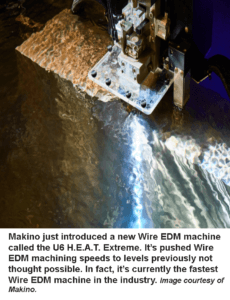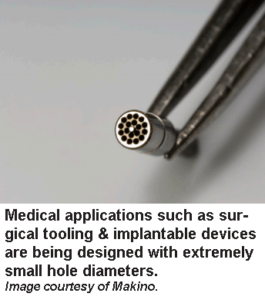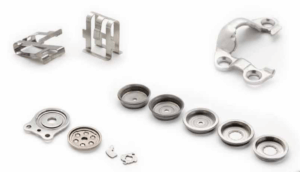When is it Time to Bring Electrical Discharge Machining (EDM) In-House?
What is Electrical Discharge Machining (EDM)?
Electrical Discharge Machining (EDM) is a non-traditional machining process. The material is removed from a workpiece, without any mechanical force on the workpiece using an electrical current that passes between an electrode and a workpiece, which is separated by a dielectric liquid.
Combined with computer numeric controls (CNC) and the use of CAD/CAM software, Electrical Discharge Machining (EDM) has become a highly accurate and reliable machining method that is now a more mainstream technology running alongside traditional machining equipment. Any conductive material can be machined on an EDM machine. Common materials include metals or metal alloys such as hardened steel, titanium, and composites. In fact, machining difficult-to-machine materials such as Hastelloy, Nitralloy, Waspaloy and Nimonic has become commonplace. The most popular use of EDM is machining molds, dies, and tools made of hardened steel and difficult-to-machine or complex workpieces on conventional machining methods.
Types of Electrical Discharge Machining?
There are three different types of Electrical Discharge Machining including wire EDM, sinker EDM and hole drilling EDM.
Wire EDM
 Also known as wire erosion, wire burning or spark EDM, wire EDM is the popular choice for manufacturers across a range of different industries. In wire EDM, a thin wire, usually brass, working as the electrode, erodes the work piece. The wire if fed from an automated feed with a spool, which can adjust cutting speed depending on wire and cutting conditions. Wire EDM is most commonly used in mold and die manufacturing processes. Other materials for wire can be used if higher performance, increased speed or improved surface finish are needed. Or if you need to EDM a thick part, you would use a high-performance wire that would withstand the heat, maintain cut consistency and resist breakage.
Also known as wire erosion, wire burning or spark EDM, wire EDM is the popular choice for manufacturers across a range of different industries. In wire EDM, a thin wire, usually brass, working as the electrode, erodes the work piece. The wire if fed from an automated feed with a spool, which can adjust cutting speed depending on wire and cutting conditions. Wire EDM is most commonly used in mold and die manufacturing processes. Other materials for wire can be used if higher performance, increased speed or improved surface finish are needed. Or if you need to EDM a thick part, you would use a high-performance wire that would withstand the heat, maintain cut consistency and resist breakage.
Sinker or RAM EDM
Also known as conventional EDM, die sinking, cavity type EDM, vertical EDM or plunge EDM. A mold is pre-machined in either graphite or copper, and becomes the electrode. This electrode removes material from the workpiece, creating the negative version of its original shape.
Hole Drilling EDM
 Also known as hole popper, fast hole EDM drilling or start hole EDM drilling. This process is used for drilling holes. It uses a hollow or tubular electrode, and can machine extremely small and deep holes without the need for de-burring or smoothing out.
Also known as hole popper, fast hole EDM drilling or start hole EDM drilling. This process is used for drilling holes. It uses a hollow or tubular electrode, and can machine extremely small and deep holes without the need for de-burring or smoothing out.
Benefits of EDM
- While Electrical Discharge Machining is not a high-speed machining process, it tends to be more predictable, accurate and repeatable. It is at home in low-volume operations with tight tolerances, such as the aerospace and medical device industries.
- EDM machining can be performed unattended resulting in lower cost to operate and manufacture.
- EDM can machine harder materials.
- EDM can create intricate shapes all with excellent surface finishes, reducing the need for secondary machining.
- EDM only uses wire, rather than expensive cutting tools that wear out. With automatic wire feed, you always have a fresh cutting tool.
- EDM is well-suited to produce high-stress, high-temperature parts.
Obvious Reasons to Bring EDM In-House
EDM is a great choice in a regular production run if you want a smooth surface finish that is accurate and burr-free without post-processing, which is often necessary with other manufacturing processes. And, if you’re concerned about setup and ease of use, most EDM machines are computer numerical controlled (CNC) and use automated software to program functions. It is also particularly popular for small-volume productions such as prototypes which can be produced at a higher quality. Prototypes using fragile or expensive material tend to be produced more cost-effectively with the EDM process due to no contact on material, smooth edges on first pass, and lower chip rate.
 With its highly complex process and lack of mechanical force placed on the workpiece, EDM may be the only option to conventional metal removal. It provides high accuracy, exact tolerances and the ability to produce intricate or complex-shaped parts, or fragile outlines with harder materials such as tungsten carbide or titanium. With an in-house EDM, a shop can control the process – from lead time, scheduling and delivery.
With its highly complex process and lack of mechanical force placed on the workpiece, EDM may be the only option to conventional metal removal. It provides high accuracy, exact tolerances and the ability to produce intricate or complex-shaped parts, or fragile outlines with harder materials such as tungsten carbide or titanium. With an in-house EDM, a shop can control the process – from lead time, scheduling and delivery.
So When is it Really Time to Buy an EDM?
To justify the first wire EDM, a shop usually measures the amount of money it spent on outsourcing EDM work last year. When it equals the monthly cost of an EDM, it makes sense to in-house the process.
But focusing just on outsourcing vs in-house costs and savings might be a little short-sighted given the benefits discussed above. And what about the hidden benefits such as offering this new process to your customers over your competition allowing you to win more work and broaden your offerings, or the opportunity to attract new customers that were looking past you for the lack of single source capability. Having new technology in-house will improve overall employee attitudes because they see themselves working for a progressive company not afraid to invest in modern technology. In fact, new technology inspires new thinking and don’t be surprised if engineering discovers new ways to do things that they never even considered prior to having EDM available. The quality of the jigs and fixtures will go up with less labor because the EDM, once running is mostly an unattended process.
At Productivity, our sales people have seen a pattern where a company is right on the edge of whether they can justify bringing an EDM in-house. Once they do make that decision they are pleasantly surprised to find they become overloaded with EDM work because of all the new applications they can now accomplish. Before 12 months are up, they will be purchasing the second machine. We’ve seen it happen more times than it doesn’t.
If you buy an EDM machine for your shop, it doesn’t have to be a one-trick pony. The possibilities are endless on how you can utilize your EDM and only take your engineering imagination to make the most of your investment. Products that were once hard to machine, can now be done on your new EDM. Productivity boasts a good range of quality EDM manufacturers to suit your needs. For more information on our EDM lines – Makino, Belmont and SmalTec, contact our sales group.